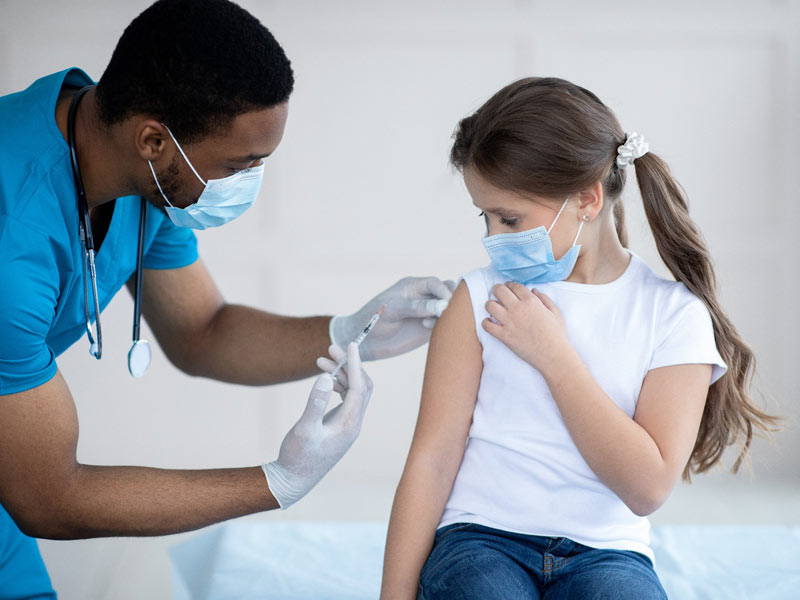U.S. Childhood Vaccination Rates Buck Global Trends
Family Physician Offers Advice on Addressing Vaccine Hesitancy
August 10, 2022, 8:54 a.m. News Staff — As the AAFP recognizes National Immunization Awareness Month, new data from UNICEF and the World Health Organization suggest that childhood vaccination rates have dropped considerably in many parts of the world, although they have mostly remained steady in the United States since the start of the COVID-19 pandemic.

The data highlight the importance of both children and adults having access to routine immunizations, an issue that has been one of the Academy’s most prominent advocacy efforts. They also indicate marked differences in childhood vaccination rates between the United States and other regions.
Although many regions experienced sharp declines in childhood immunization rates between 2019 and 2021, UNICEF’s immunization profile for the United States and the WHO’s immunization data dashboard suggested that coverage rates for most immunizations here remained constant, and often exceeded global coverage rates. The organizations estimated that in the United States, about
- 93% of children received the third dose of the DTaP vaccine,
- 92% received the third dose of polio-containing vaccine,
- 95% received the second dose of meningococcal virus vaccine,
- 92% received the third dose of hepatitis B vaccine,
- 91% received the third dose of Haemophilus influenzae type b vaccine and
- 64% of girls and 60% of boys had received their final dose of HPV vaccine by age 15 years.
The only substantial decline concerned the pneumococcal conjugate vaccine. Both organizations estimated that about 82% of eligible U.S. children received their third dose of the vaccine in 2021 compared with 92% in 2019.
Story Highlights
Family Physician Perspective
Gretchen LaSalle, M.D., a 2020-2021 AAFP Vaccine Science Fellow and clinical associate professor for the Washington State University Elson S. Floyd College of Medicine in Spokane, said that while she wasn’t surprised that vaccination rates in other parts of the world declined during the pandemic, she was surprised to see that they remained relatively high in the United States.
“During the early part of the pandemic, CDC data showed a significant drop-off in ordering and administration of routine childhood immunizations,” LaSalle said. “However, family physicians and pediatricians have been working hard to make up for lost time and those efforts seem to be paying off.”
Although data for the United States remained fairly constant, LaSalle expressed concerns about potential long-term physical, social and financial repercussions if vaccination rates fall here.
“We don’t yet know how a COVID illness now will affect people in the future, but we do know other viruses like chickenpox, polio, HPV and measles can cause life-altering or deadly effects that only show up years later,” LaSalle said.
“To those who are hesitant, I would say that we have decades upon decades of data showing that vaccines are extremely safe and effective.,” LaSalle continued. “If I were a betting person, all my bets would be on vaccination as the best choice to safeguard the current and future health of our children and ourselves.”
Many AAFP members have shared the experience of talking with patients who are vaccine-hesitant or question their effectiveness. LaSalle offered suggestions for those discussions:
- Don’t make assumptions about the reasons behind patients’ vaccination decisions; let them talk.
- Be inviting, respectful and curious.
- “Remember that people are trying to make the best decisions they can with the information they have,” LaSalle said. “If we can empathize with how difficult it is to tell good information from bad on the internet and social media, we can approach the conversation with less frustration and more willingness to hear that person’s concerns.”
- Use motivational interviewing with the 3A approach of ask, acknowledge, advise.
- “Let patients know that you vaccinate yourself and your family, and that you want the same level of care for them that you want for your own loved ones,” LaSalle said.
- Link vaccine recommendations to something personal in the patient’s life. “Use stories — they evoke emotions, and emotions are powerful,” she said. “We see the devastation that vaccine-preventable disease causes, and we want to protect them and their loved ones from having to suffer.”
- “And don’t forget to discuss vaccines at every visit, not just wellness visits,” she said. “That appointment for migraines or birth control or a sprained ankle is the perfect time to catch people up on any missed immunizations.”
Finally, LaSalle reminded FPs that while discussions about vaccination with hesitant patients can feel overwhelming, they’re still important.
“Take a deep breath,” she advised. “Remember that you aren’t there to force a pro-vaccine decision. You are there to be a trusted source of information that will allow patients to make a more informed choice, and if their decision is initially against vaccinating, leave the door open for future conversations. People change their minds all the time and we will be there with open arms when they do.”
AAFP Resources
The Academy has created a wealth of vaccine and immunization resources for FPs and their patients.
The AAFP’s Immunizations & Vaccines webpage directs members to a variety of tools and educational materials, including the latest immunization schedules from the CDC, the Shots Immunizations app, and a collection of review articles, news stories and blog posts.
Among the latest Academy resources are two factsheets: How to Approach Conversations With Parents About Routine Pediatric Vaccinations and Building Confidence When Talking to Parents About Children’s Vaccines. Both factsheets, developed in collaboration with Pfizer Inc. , and are available on the “Resources to Support Your Patient Vaccine Conversations” section of the Immunizations & Vaccines webpage.
The Academy has also created CME activities on increasing adult immunization rates and published patient-related materials at familydoctor.org.
Additional immunization resources will be available from the AAFP in the coming weeks. Be sure to visit the Immunizations & Vaccines webpage for the latest updates.